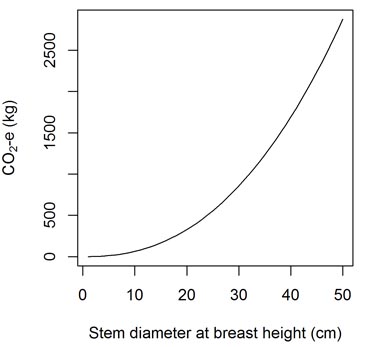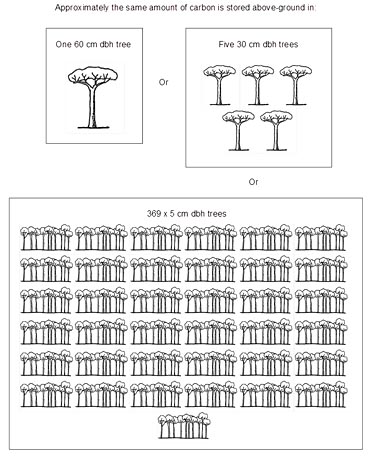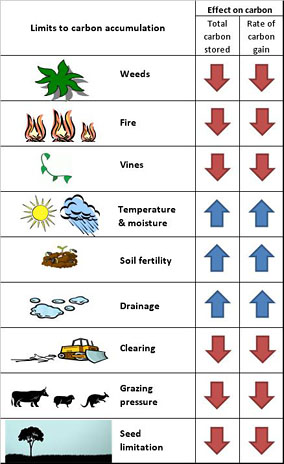Farming carbon

Potential to store carbon
- Above-ground carbon in rainforest is stored in living trees, dead standing trees, fallen timber and litter.
- Based on sites in Queensland, wet rainforest has the potential to store from 300 to more than 1700 tonnes of carbon dioxide equivalent per hectare.
- Dry rainforest has the potential to store from 170 to more than 800 tonnes of carbon dioxide equivalent per hectare.
- The maximum accumulation rate of wet rainforest can exceed 15 tonnes per hectare of carbon dioxide equivalent per year, while the rate is likely to be slower for dry rainforest.
Carbon farming might not always mean bringing rainforest back to its full carbon capacity as soon as possible. Some carbon returns might be traded off against other land-uses, such as selective timber harvesting, which may limit carbon accumulation rates.
Note: to generate carbon credits you will need to register a project with the Clean Energy Regulator using an approved method. The methods detail the conditions or rules for generating carbon credits (Australian Carbon Credit Units) and how vegetation is to be managed as part of a project.

Carbon storage and tree size
Large trees hold far more carbon than small trees because the amount of carbon held increases exponentially as the trunk diameter of a tree increases. For example, the carbon held above ground in a large tree (e.g. 60cm in diameter) is about the same as that held in 350 smaller trees (e.g. 5cm diameter).
| Tree dbh (cm) | Dry matter (kg) | Carbon (kg) | CO2 equivalent (kg) |
|---|---|---|---|
| 5 | 7 | 3 | 12 |
| 30 | 497 | 233 | 856 |
| 60 | 2567 | 1206 | 4423 |
The approximate amount of above-ground dry matter, carbon and carbon dioxide equivalent stored in rainforest trees of different diameters. Dbh = stem diameter measured at 1.3m height.


Limits to carbon accumulation
Carbon accumulation in rainforest is limited by several factors including fire, grazing pressure and seed limitation. While some of these factors are largely determined by the location of the site (e.g. temperature and moisture, and drainage) others can be influenced by management.
The total amount of carbon stored by rainforest, and the rate it accumulates, can be maximised by removing these limits where possible.
Weeds
Competition from weeds and other plants will generally be the most important, manageable limiting factor in the rate of carbon gain for rainforest restoration. Weeds slow the recruitment and growth of rainforest species, and many also increase the risk of fire.
Fire
Large and intense fires result in carbon loss by consuming the carbon stored in all parts of rainforest (trees, dead wood and litter).
Repeated small fires reduce the rate of carbon gain by removing small trees and shrubs, reducing the size of rainforest patches, and decrease the capacity of the vegetation to store carbon by limiting the recruitment of rainforest species.
Vines
Native vines are an important and characteristic life form in established rainforests, but can be a major problem during early stages of forest restoration.
Competition and smothering by vines decreases the rate of carbon accumulation by slowing the early stages of tree growth. Heavy vine infestations can limit the amount of carbon stored by causing tree death and limiting the recruitment of tree species.
Temperature and moisture
Rates of carbon accumulation may be slower at sites that are colder or drier.
Soil fertility
Plant establishment and growth will generally be better on sites with more fertile soils, and this will increase carbon accumulation if other limiting factors are managed. You should avoid using fertiliser in most circumstances because additional nutrients will encourage weeds.
Drainage
Poorly drained sites will generally have slower rates of carbon accumulation.
Clearing
Clearing rainforest will reduce the rate of carbon gain, decrease the capacity of the vegetation to store carbon, and produce a net carbon loss.
Grazing pressure
Grazing pressure can remove rainforest trees, and prevent their establishment and growth, which will reduce the rate of carbon gain, and the capacity of the vegetation to store carbon. Moderate levels of grazing may be compatible with the conservation of existing patches of dry rainforest.
Seed limitation
Availability of seeds can limit the amount and diversity of plant establishment in rainforest restoration. Sites close to seed sources, with resources that attract seed-dispersing animals (such as feed trees and perches), will receive more seeds and may therefore achieve faster carbon accumulation.



